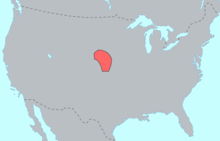Pawnee language
| Pawnee | |
|---|---|
| Native to | United States |
| Region | North-central Oklahoma |
| Ethnicity | 2,500 Pawnee (2007) |
|
Native speakers
|
100 (2007) |
|
Caddoan languages
|
|
| Language codes | |
| ISO 639-3 | |
| Glottolog | pawn1254 |
| Linguasphere | 64-BAB-b |

Pre-contact distribution of Pawnee
|
|
The Pawnee language is a Caddoan language spoken by some Pawnee Native Americans who now live in north-central Oklahoma. Their traditional historic lands were along the Platte River in what is now Nebraska.
Two important dialect divisions are evident in Pawnee: South Band and Skiri. The distinction between the two dialects rests on differences in their respective phonetic inventory and lexicon.
Once the language of thousands of Pawnees, today Pawnee is spoken by a shrinking number of elderly speakers. As more young people learn English as their first language, the status of Pawnee declines towards extinction. However, as of 2007, the Pawnee Nation is developing teaching materials for the local high school and for adult language classes. Now, there are extensive documentary materials in the language archived at the American Indian Studies Research Institute.
The following describes the South Bend dialect.
Pawnee has eight consonant phonemes, and according to one analysis of medial- and final-position glottal stops, one may posit a ninth consonant phoneme.
Pawnee has four short vowel phonemes and four long counterparts (also phonemic).
Pawnee is both a polysynthetic language and an ergative-absolutive language.
The Pawnee alphabet has 9 consonants and 8 vowels. The letters are relatively similar in pronunciation to their English counterparts.
...
Wikipedia
